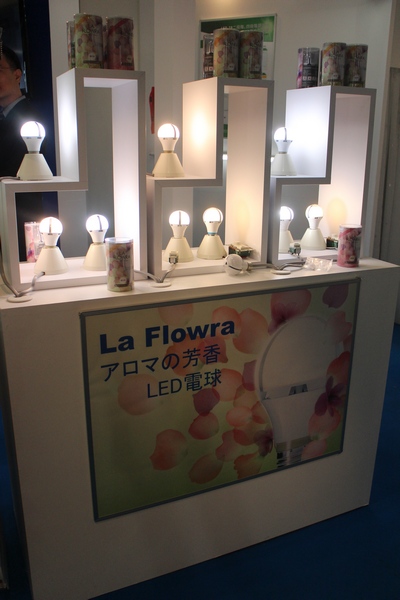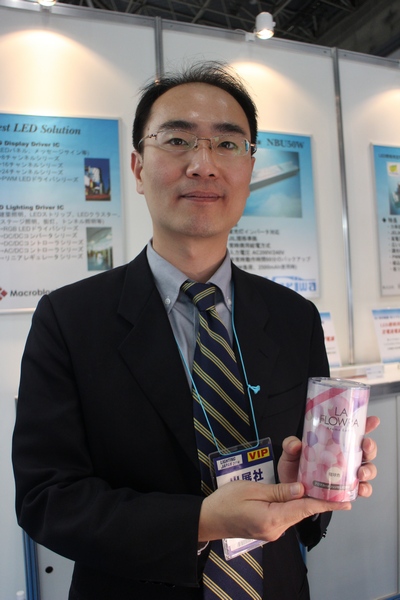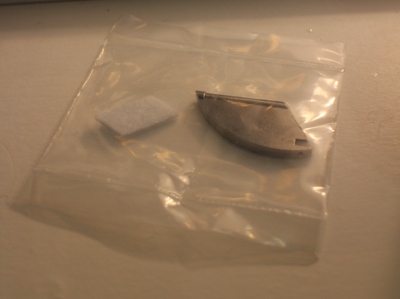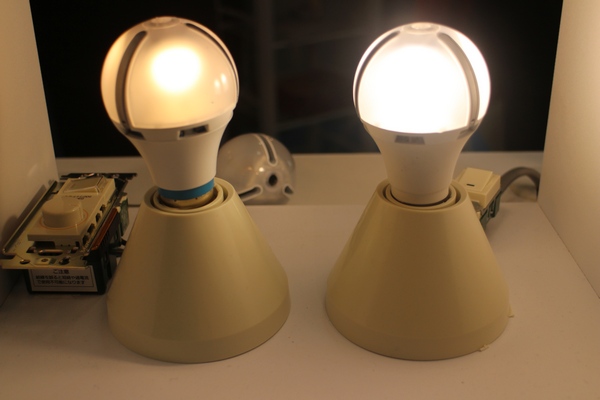Walking along the aisles close to the prototype lighting section at Lighting Japan 2014 at Tokyo Big Sight on Jan. 17, one could not miss the heavily perfumed smells of roses and stock that drifted out from Taiwanese LED manufacturer Macroblock’s booth.

|
|
LED bulbs that actually smell nice. The Flowra LED bulb series. (LEDinside) |
A closer inspection showed the smells were being released by La Flowra series LED bulbs by Macroblock. Launched in early 2013 and mass produced around Aug. in the same year, the bulbs received a lot of attention in Japan. The sweet smelling bulbs were featured in a Nikkei Asian Review report highlighting the future development of LED bulbs on Jan. 8, 2014.
 |
|
Chicco Sheu, Department Sales Manager, Lighting Product Sales Dep., Macroblock holds La Flowra in his hands. (LEDinside) |
The bulbs uses Nichia LED components, said Chicco Sheu, Department Sales Manager, Lighting Product Sales Dep., Macroblock. The bulbs come in two models the E26 and E27, with one being warm white and white. The white colored LED bulbs use Nichia 757 LEDs and emits 810 lumens of light. On average both models have more than 800 lumens, and CRI over 80, added Sheu.
 |
|
Removable aromatic component used in La Flowra LED bulbs series. (LEDinside) |
In addition, the bulbs are energy efficient. A removable aromatic component in the bulb relies on heat generated from the LED bulbs heat dissipation system, so no additional electricity is required. The aroma component design was particularly difficult for the manufacturer. “It took us six months to complete the bulb design, but a lot of time was spent designing the aroma component,” said Sheu. “It took us one year to complete the bulb.”
 |
|
Macroblock's La Flowra warm colored LED bulb (left) and white color LED bulb (right). (LEDinside) |
The aroma components are sold separately from the bulb, and a single aroma piece can last up to about four months per use. “I chose rose and stock because the 100 percent essential oil for these two particular plants is more economic than others,” said Sheu. Due to the high costs involved for the essential oil materials, the bulbs are more expensive than regular bulbs. According to Sheu the aromatic bulbs are priced around 4,000 Japanese Yen (US$ 38.32), and the company hopes to target mid-end markets, such as hotels and spas with this particular product.
The bulbs are probably the first example of manufacturers attempt of incorporating the senses sight and smell into a light bulb. Most manufacturers have mostly been trying to add value to bulbs with better lighting controls, interactive features, customizable colors, or in the case of French LED manufacturer’s Awox adding music playing features to LED bulbs. Smell is now becoming another potential market for LED bulb applications.











